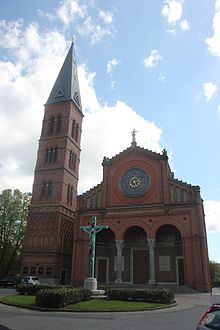Jesus Church, Copenhagen
| Jesus Church | |
|---|---|

Jesus Church seen from across the street
|
|
| 55°39′55″N 12°31′19.5″E / 55.66528°N 12.522083°ECoordinates: 55°39′55″N 12°31′19.5″E / 55.66528°N 12.522083°E | |
| Location | Kirkevænget 5b 2500, Valby, Copenhagen |
| Country | Denmark |
| Denomination | Church of Denmark |
| Architecture | |
| Status | Church |
| Architect(s) | Vilhelm Dahlerup |
| Style | Historicism |
| Completed | 1895 |
| Specifications | |
| Length | 50 m |
| Width | 17.5 |
| Height | 52 m (campanile) |
| Materials | Brick |
| Administration | |
| Archdiocese | Diocese of Copenhagen |
The Jesus Church (Danish: Jesuskirken) is a church situated just off Valby Langgade in the Valby district of Copenhagen, Denmark. It was commissioned by second-generation Carlsberg brewer Carl Jacobsen and designed by Vilhelm Dahlerup. Noted for its extensive ornamentation and artwork, it is considered to be one of the country's most idiosyncratic and unconventional examples of church architecture. The church was built as a mausoleum for Carl Jacobsen and his family and is located close to their former house as well as the former Carlsberg brewery site. Their sarcophagi lie in the crypt. Throughout the church, there are ornaments and inscriptions associated with the family.
Jacobsen's father, J. C. Jacobsen, had decided to bequeath Gammel Carlsberg to the Carlsberg Foundation. On his death, Carl Jacobsen received a sum of 1,000,000 Danish kroner. In 1883, he and his wife Ottilia decided to divide the money into four equal amounts, creating four "Ny Carlsberg Grants". The first of these was the "Ny Carlsberg Church Grant" that was to fund the creation of a new church in Valby within 10 years.
Jacobsen had already acquired the land in 1879 and in 1882 he assigned Vilhelm Dahlerup to the project. He requested a church which would "surpass all other churches in Copenhagen in beauty", specifying that it should be in the style of early Christian basilica architecture as seen in Italy and France.
The sum proved inadequate but, thinking more about art than money, Carl Jacobsen continued the project regardless. On completion of the work, the costs had exceeded the original budget fourfold.
...
Wikipedia
